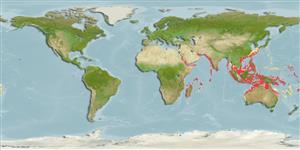Common names from other countries
Environment: milieu / climate zone / depth range / distribution range
Écologie
marin démersal; profondeur 50 - 120 m (Ref. 42740). Tropical
Indo-West Pacific: Persian Gulf to the continental shelf of Asia, the Philippines, Indonesia, and northwestern Australia.
Taille / Poids / Âge
Maturity: Lm ? range ? - ? cm
Max length : 27.0 cm TL mâle / non sexé; (Ref. 11441)
Épines dorsales (Total) : 5; Rayons mous dorsaux (Total) : 22; Épines anales: 1; Rayons mous anaux: 18 - 19. Light red dorsally, shading to white ventrally, the scale edges brown except ventrally. Two longitudinal rows of indistinct light red blotches on body, ending in 2 dark red spots on base of caudal fin. Snout light blue with oblique yellow lines. Eye not very large, its diameter more than 4 times in head length of adults. Third and fourth dorsal-fin spine longest. Last interspinous membrane of dorsal fin connected to base of first soft ray (Ref 42740).
A coastal species (Ref. 42740) found in trawling grounds.
Life cycle and mating behavior
Maturities | Reproduction | Spawnings | Egg(s) | Fecundities | Larves
Allen, G.R. and R. Swainston, 1988. The marine fishes of north-western Australia: a field guide for anglers and divers. Western Australian Museum, Perth. 201 p. (Ref. 3132)
Statut dans la liste rouge de l'IUCN (Ref. 130435)
CITES (Ref. 128078)
Not Evaluated
Menace pour l'homme
Harmless
Utilisations par l'homme
Outils
Articles particuliers
Télécharger en XML
Sources Internet
Estimates based on models
Preferred temperature (Ref.
115969): 22.4 - 28.1, mean 26.1 (based on 401 cells).
Phylogenetic diversity index (Ref.
82804): PD
50 = 0.5000 [Uniqueness, from 0.5 = low to 2.0 = high].
Bayesian length-weight: a=0.00724 (0.00412 - 0.01274), b=3.05 (2.90 - 3.20), in cm Total Length, based on LWR estimates for this species & Genus-body shape (Ref.
93245).
Niveau trophique (Ref.
69278): 3.6 ±0.4 se; based on size and trophs of closest relatives
Résilience (Ref.
120179): Milieu, temps minimum de doublement de population : 1,4 à 4,4 années (Preliminary K or Fecundity.).
Fishing Vulnerability (Ref.
59153): Low vulnerability (17 of 100).
